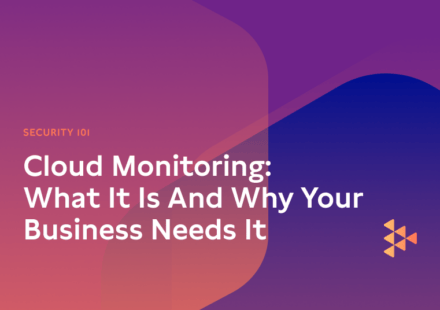So, you’ve built up your tech stack and are using one of the leading cloud providers like AWS, Microsoft Azure, or Google Cloud Platform (GCP) to host your infrastructure – and your data is secure, right?
This is one of the biggest misconceptions about cloud monitoring. In reality, AWS, Microsoft Azure, and GCP may be secure on their end, but they cannot secure data and implement security and privacy best practices for you.
The global public cloud services market is expected to grow by nearly 22% in 2023 (equal to just under $600 billion USD), according to a 2023 Statista report. This rapid growth in cloud computing means businesses, small and large, will continue to leverage large cloud providers’ services to house their data and applications.
As a result, cloud security has become a critical concern for organizations of all sizes. In the face of rapidly evolving cyber threats, it is important for organizations to adopt effective security measures to protect their cloud assets. One such measure is cloud monitoring. In this blog post, we will explore the following questions:
What is Cloud Monitoring?
Cloud monitoring is the process of continuously tracking and analyzing the performance and security of cloud-based systems, applications, and services. It is used to detect and prevent potential security risks and ensure that the cloud environment is operating optimally. Key components of cloud monitoring include security event monitoring, performance monitoring, and infrastructure monitoring.
In public cloud environments like AWS, Microsoft Azure, or GCP, organizations benefit from the economies of scale and shared resources provided by the cloud service provider. However, public cloud environments also pose security risks, such as data breaches and unauthorized access to sensitive information. To mitigate these risks, organizations should implement best practices for cloud monitoring, including continuous monitoring, automated monitoring, and regular security audits and assessments.
Why is Cloud Monitoring Important?
Cloud monitoring is essential for maintaining the performance, security, and efficiency of your cloud environment. It enables you to identify and address issues, optimize resources, and ensure compliance with security frameworks. Incorporating the following capabilities into a cloud monitoring tool ensures a proactive, effective, and holistic approach to managing security, compliance, and risk within your cloud environment.
Gap Analysis
Performing a gap analysis is an essential first step because it illuminates the areas of your cloud environment that are lacking and not up to par with industry standards. Frameworks like NIST 800-53 provide a suite of controls that can be used to establish a security baseline in your cloud environment. Leveraging a gap analysis shows where your security has potential weaknesses and vulnerabilities. By knowing what needs to be improved based on recommendations on controls from a framework like NIST 800-53, you can reduce the risk profile in your cloud environment. Finally, your tool should be performing periodic gap analysis as threats evolve over time.
Evidence Collection
Evidence collection follows a thorough process of identifying when an incident occurred, analyzing your environment to see what is affected by the breach, documenting and recording which assets were affected (This can include capturing timestamps, documents, and other digital information), and where applicable, who was responsible for them. This process gives a reliable source of truth when it comes time to prepare for a security audit. Finally, a comprehensive report detailing the incident, the evidence collected, the conducted analysis, and the impact of the incident are generated. This report is crucial for internal teams, legal proceedings, and regulatory compliance purposes.
Continuous Monitoring
Continuous monitoring is a critical component of effective and efficient cloud monitoring. Organizations can detect and prevent potential security risks by continuously monitoring cloud-based systems and applications in real time. Automating your continuous monitoring removes repetitive and time-consuming tasks, freeing up resources and allowing you to focus your time and energy on other areas of your business.
Integrating cloud monitoring with other security tools, such as firewalls and intrusion detection systems, can provide organizations with a comprehensive view of their cloud security posture. Regular security audits and assessments can help organizations identify and address potential security risks and ensure that their cloud environment operates optimally.
Regulatory Compliance
Maintaining compliance with industry-specific regulations is a significant concern, especially for businesses in regulated sectors such as finance or healthcare. Cloud monitoring helps in monitoring data access, encryption, and privacy controls, ensuring that compliance requirements are met even as the organization scales its operations.
There are several security frameworks that organizations can use to guide their cloud monitoring efforts. Some of the most commonly used frameworks include the National Institute of Standards and Technology Cybersecurity Framework (NIST), its special publication like NIST 800-53, and the Federal Risk and Authorization Management Program (FedRAMP).
The NIST Cybersecurity Framework provides guidelines for organizations to manage and reduce cybersecurity risks with a set of standards, guidelines, and best practices that organizations can use to enhance their cloud security posture.
FedRAMP is a security framework that provides a standardized approach for the assessment and authorization of cloud products and services. It was created to provide a secure environment for government agencies to store sensitive information in the cloud. The framework includes security controls and guidelines that organizations can use to secure their cloud environments.
Next Steps: How Carbide Helps You Keep Your Cloud Environment Secure
Cloud monitoring is a critical tool for organizations that rely on cloud providers like AWS, Microsoft Azure, or GCP. Organizations must adopt effective cloud monitoring strategies to protect their cloud assets and ensure the security and reliability of their cloud environments. Book a demo today to learn how the Carbide Platform helps you surpass check-box security and provides the guidance and tools you need to create, operate, and optimize it.

